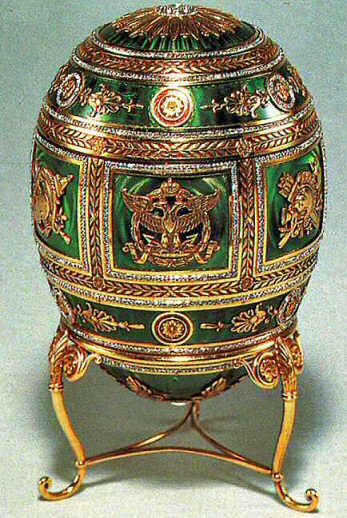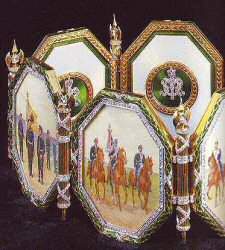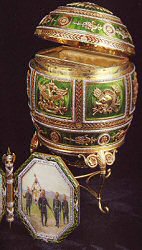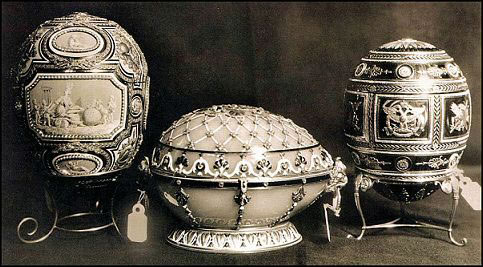1912 Napoleonic Egg
Gift Nicholas
II to Maria Feodorovna
Made in Saint Petersburg
Owner: Matilda Geddings
Gray Foundation,
New Orleans Museum of Art, Louisiana, USA
November 22, 2011 – November 2021 - Long-term Installation in New York Metroplolitan Museum of Art (Expanded date!)
Height: 11,7 cm

The 1912 Napoleonic Egg is made of yellow gold, translucent emerald
green, and ruby redenamel, rose-cut diamonds, velvet and 
 satin.
The miniature screen is made of yellow gold, rose-cut diamonds,
platinum, translucent emerald green, and opaque white enamel,
gouache on ivory.
satin.
The miniature screen is made of yellow gold, rose-cut diamonds,
platinum, translucent emerald green, and opaque white enamel,
gouache on ivory.
Made for Dowager Empress Maria Feodorovna, this Egg commemorates the centenary of Russia's victory over the armies of Napoleon and in particular the victory at Borodino in 1812. The Dowager Empress Maria served as honorary colonel for the six regiments depicted in watercolor, and her monogram decorates the back of each panel.
These panels, signed Vasilii Zuiev and dated 1912, form a screen whose hinges are ax-topped fasces, a warlike emblem in use since Roman times. Double-headed eagles and battle trophies embellish the green shell. Like enormous history-painting cycles from earlier centuries, the Napoleonic Egg celebrates past royal glories while appealing to Russian patriotism at a time when the Romanov dynasty once again faced the uncertainties of war.
The reverse of each panel is enameled in translucent opalescent white in which a crowned cyrillic script cipher of the Dowager Empress is centered. On top of the Egg, under a portrait diamond, the crown and the monogram of Maria Feodorovna.

Background information
Maria Feodorovna was a honorary colonel for six regiments and was very popular with the troops. They regarded her as the true Tsarina of Russia and certainly they did not view Alexandra in the same light!
The Napoleonic Egg is one of only two Imperial Easter Eggs for which design drawings have so far been found, the other being the 1909 Standart Egg.
In 1930 the Napoleonic Egg was one of the ten Eggs sold to the Hammer Galleries, New York. 1927 in a private collection. 1951 owned by Matilda Geddings Gray, oil-heiress. 1971 Collection of the late Matilda Geddings Gray, 1972 Matilda Geddings Gray Foundation, New Orleans Museum of Art, USA.

The 1914 Catherine the Great Egg, the 1894 Renaissance Egg and the 1912 Napoleonic Egg photographed in Moscow in the 1930's before they were sold abroad. Courtesy Fabergé Research Newsletter, April 2017.
Page updated: April 5, 2018
